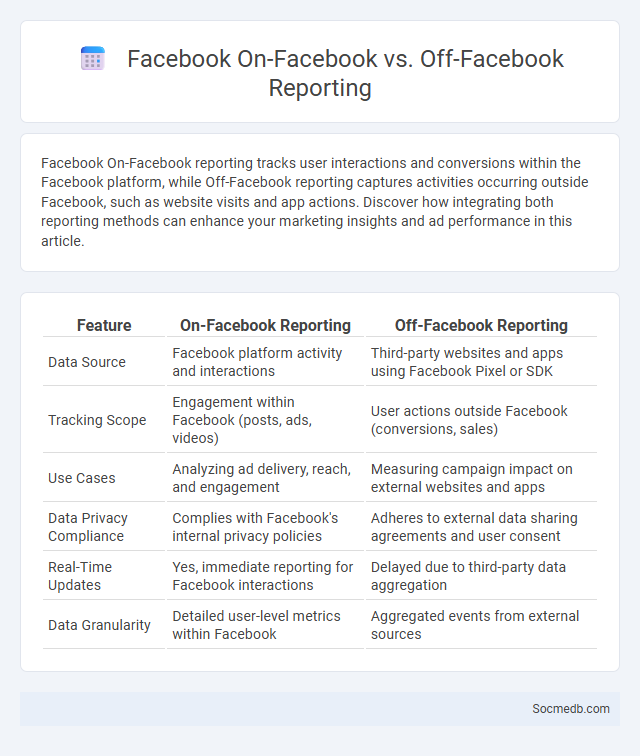
Photo illustration: Facebook On-Facebook vs Off-Facebook Reporting
Facebook On-Facebook reporting tracks user interactions and conversions within the Facebook platform, while Off-Facebook reporting captures activities occurring outside Facebook, such as website visits and app actions. Discover how integrating both reporting methods can enhance your marketing insights and ad performance in this article.
Table of Comparison
| Feature | On-Facebook Reporting | Off-Facebook Reporting |
|---|---|---|
| Data Source | Facebook platform activity and interactions | Third-party websites and apps using Facebook Pixel or SDK |
| Tracking Scope | Engagement within Facebook (posts, ads, videos) | User actions outside Facebook (conversions, sales) |
| Use Cases | Analyzing ad delivery, reach, and engagement | Measuring campaign impact on external websites and apps |
| Data Privacy Compliance | Complies with Facebook's internal privacy policies | Adheres to external data sharing agreements and user consent |
| Real-Time Updates | Yes, immediate reporting for Facebook interactions | Delayed due to third-party data aggregation |
| Data Granularity | Detailed user-level metrics within Facebook | Aggregated events from external sources |
Understanding Facebook Reporting: An Overview
Facebook reporting offers detailed insights on user engagement, ad performance, and page analytics, enabling businesses to optimize their social media strategies. Key metrics include reach, impressions, click-through rates, and conversion tracking, which reveal audience behavior and campaign effectiveness. Utilizing Facebook's Ads Manager and Analytics tools helps marketers create data-driven decisions to improve brand visibility and ROI.
Defining On-Facebook Reporting
On-Facebook Reporting provides detailed analytics directly within the Facebook platform, helping you track engagement, reach, and conversion metrics without the need for external tools. This feature offers real-time insights into your campaigns, allowing precise adjustments to optimize ad performance and audience targeting. Utilizing On-Facebook Reporting enhances your social media strategy by delivering actionable data tailored to your specific marketing goals.
What is Off-Facebook Reporting?
Off-Facebook Reporting is a privacy-focused method that allows advertisers to analyze conversion data from users without relying on direct Facebook tracking pixels. This approach uses aggregated and anonymized data sources outside Facebook's ecosystem to measure campaign performance across websites and apps. It helps businesses understand ad impact while complying with privacy regulations like GDPR and CCPA.
Key Differences: On-Facebook vs Off-Facebook Reporting
On-Facebook reporting provides detailed insights into user interactions, ad performance, and audience demographics directly within the platform, leveraging Facebook's proprietary data for precise measurement. Off-Facebook reporting captures actions and conversions occurring outside the platform, such as website visits and app activity, using tracking tools like the Facebook Pixel and Conversion API to connect offline behavior with ads. The primary difference lies in data origin: on-Facebook reports measure engagement within Facebook and Instagram environments, while off-Facebook reports analyze user actions across external digital properties for a holistic view of campaign effectiveness.
Data Sources Utilized in Each Reporting Method
Social media reporting methods rely on diverse data sources including user engagement metrics, sentiment analysis, and platform-specific insights such as likes, shares, and comments from Facebook, Twitter, and Instagram. Real-time data streams from APIs and third-party analytics tools provide comprehensive visibility into trends and audience behavior. To maximize your social media strategy, understanding how each reporting method harnesses these distinct data sources is crucial for accurate performance evaluation.
Attribution and Conversion Tracking Explained
Attribution and conversion tracking allow you to measure the effectiveness of your social media campaigns by identifying which platforms and touchpoints lead to customer actions like purchases or sign-ups. By analyzing attribution models such as last-click, first-click, or multi-touch, you can optimize budget allocation and improve your return on investment. Proper implementation of tracking pixels and UTM parameters ensures accurate data collection, enabling you to refine strategies and maximize your social media marketing impact.
Privacy Implications for Both Reporting Types
Social media platforms collect vast amounts of personal data that can impact your privacy whether you engage in active reporting, such as posting content, or passive reporting, like browsing and liking. Active reporting exposes sensitive personal details directly, increasing risks of identity theft and profiling, while passive reporting can lead to covert data collection and behavioral analysis by third parties. Understanding these privacy implications helps you make informed decisions about the information you share and how it is monitored online.
Optimizing Campaigns: Which Reporting Should You Trust?
Reliable social media campaign optimization depends on accurate reporting from platform insights, third-party analytics, and direct user engagement metrics. Prioritize data reflecting authentic interactions and conversions to ensure your campaign adjustments drive measurable results. By trusting comprehensive reports that align with your marketing objectives, you can enhance your strategies and maximize ROI effectively.
Common Pitfalls in Facebook Reporting
Facebook reporting often presents challenges such as inaccurate attribution of conversions, data sampling errors, and discrepancies between Facebook and Google Analytics metrics. Misinterpreting these reports can lead to ineffective ad spend decisions and misaligned marketing strategies. To optimize your campaigns, you must regularly validate data accuracy and understand Facebook's reporting limitations.
Best Practices for Accurate Facebook Advertising Reports
Accurate Facebook advertising reports rely on implementing best practices such as setting clear campaign objectives, tracking relevant key performance indicators (KPIs) like click-through rates and conversion rates, and using Facebook Pixel for precise audience measurement. Your data analysis should include regular monitoring to identify trends and anomalies, ensuring that reporting reflects actual ad performance without discrepancies. Utilizing Facebook's Ads Manager tools alongside third-party analytics can further enhance report accuracy and optimize your advertising strategy.
 socmedb.com
socmedb.com